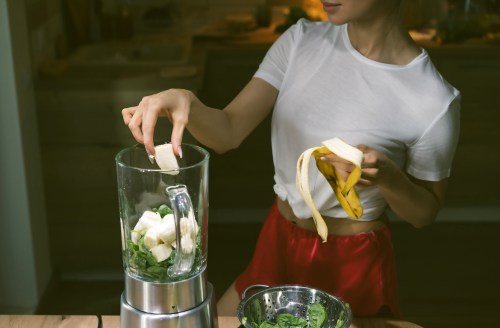Our editors independently select these products. Making a purchase through our links may earn Well+Good a commission
The Exact Order You Should Be Adding Smoothie Ingredients to Your Blender (So You Can Avoid Ever Having to Stop-and-Stir Again)
This blender hack will make your smoothies consistent without having to stir it or run multiple cycles. Here's how to blend smoothies better.

If there is a more refreshing or delicious respite from a hot summer’s day than a cold, fresh fruit smoothie, we have yet to find it. While you could certainly head over to your local smoothie shop to procure your go-to strawberry-banana-coconut milk concoction, you’re probably better off making your smoothies in the comfort of your own home—after all, how else can you be sure that your blend of fruits, vegetables, and yogurt (or whatever other ingredient your heart desires) is truly to your liking?
And while you have likely perfected the smoothie recipe by now, you may have found that you have yet to perfect the smoothie technique. It’s a familiar story—you toss in your ingredients, press the ‘Start’ button, and quickly find that you have to constantly stop your appliance to stir your smoothie around to ensure that everything is properly mixed. (Ack, talk about a dangerous activity to attempt before you’ve had your morning coffee.) You might also find that you consistently have to run several cycles on your blender, which means you end up with some still-frozen chunks and other exceedingly runny components. Not fun.
There is, however, a solution—and it doesn’t involve buying a new blender. In fact, it doesn’t involve buying anything at all. Rather, the fix to the stop-and-stir dilemma is all about the order in which you drop your ingredients into your blender. That’s it.
Ready to have a far (ahem) smoother breakfast-making routine? As the experts from professional blender brand Ninja shared with us, there is a very specific order of ingredient layers that you should follow if you want to get the most out of your blender. Follow these steps and we promise your blender’s blade will stop getting jammed up in your frozen pineapple.
The right way to order your smoothie ingredients in the blender
1. Start with the liquid on the bottom.
Whether you’re working with milk, a milk alternative, juice, or coconut water, this is always the first ingredient that you should start with, the Ninja experts say. This allows your blender to actually work its magic. The spinning of the blades creates a vortex, which sucks harder ingredients (we’ll get to those later) down into the little tornado being created in your blender.
2. Add any fine powders.
For those who are fans of protein powder or powdered peanut butter, you’ll want to add these ingredients immediately after your liquid. This helps to ensure that the powder is fully incorporated into your finished product, rather than clumped in odd, chalky ways.
3. Drop in those fresh fruits and veggies.
If you’re going for a green smoothie, this is the time to add the spinach, kale, or other leafy greens. Note that if you are going to use greens, you may want to add a little bit of blending time to ensure that the blades can break down the fibers in these raw veggies.
You can also add your fresh fruits right along with your greens. Put the softer ones in first (like berries, bananas, and peaches) and harder fruits in second so that their weight can push down your other ingredients.
4. Follow with creamy components.
Next comes creamy ingredients like yogurt, nut butter, or silken tofu.
5. Finish up with frozen fruit, ice, nuts, and other hard ingredients on top.
The last thing to go into your blender should be your frozen ingredients—this includes frozen fruit and ice. Nuts and seeds could also be added at this point, if that’s your jam.
Why does the order of ingredients matter so much?
TL; DR: Put the most liquid-like foods on the bottom and finish with the most solid foods on top. Creamy and soft ingredients get sandwiched in-between.
The science here is simple: You want the blender blades to be able to start whirring at full speed before heavier, harder ingredients can bring them to a halt. This method also helps you avoid a phenomenon known as cavitation, which happens when your mix of ingredients is too cold. Cavitation causes an air pocket to form around the blade, preventing it from actually doing any blending. You can prevent this by ensuring that there’s plenty of space between your cold, hard ingredients and your liquids at the bottom.
If you are in the market for a new blender (or just a blender at all), our favorites—in addition to the Ninja Personal Blender—include the Hurom Hexa, a super powerful option that can blend, mix, and chop; and the perennially popular Vitamix, perfect for protein shakes, smoothies, soups, and anything else you toss into it.
Oh hi! You look like someone who loves free workouts, discounts for cult-fave wellness brands, and exclusive Well+Good content. Sign up for Well+, our online community of wellness insiders, and unlock your rewards instantly.
Sign Up for Our Daily Newsletter
Get all the latest in wellness, trends, food, fitness, beauty, and more delivered right to your inbox.
Got it, you've been added to our email list.










